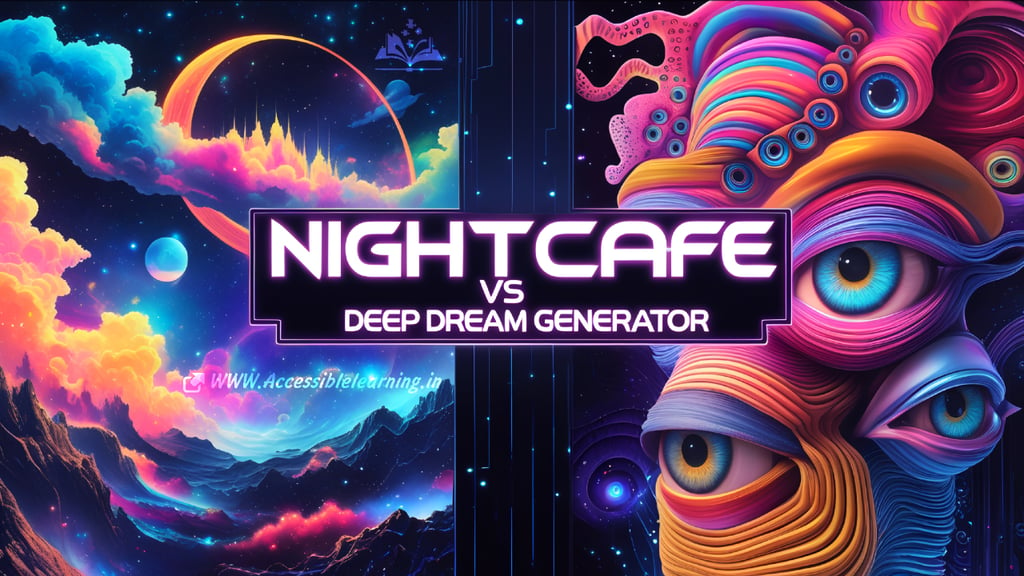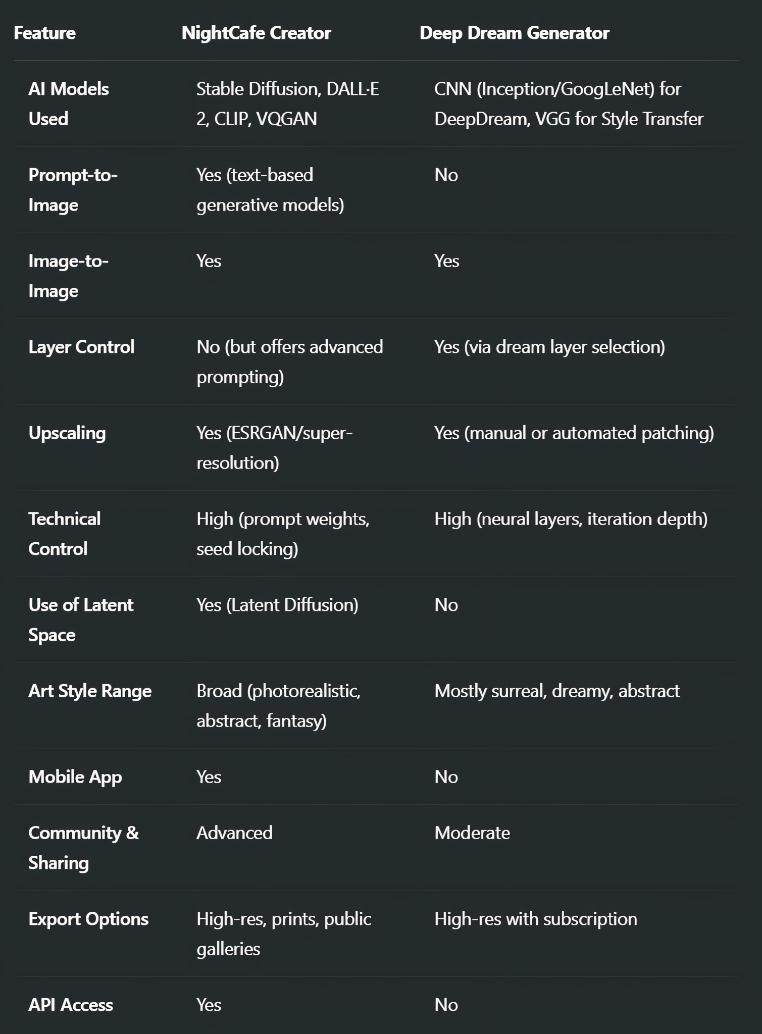
NightCafe vs Deep Dream Generator: Features, Use Cases & Advanced Insights
Explore the in-depth comparison of NightCafe Creator vs Deep Dream Generator—two leading AI art platforms. Discover features, algorithms, use cases, and expert insights to choose the right tool for your creative journey.
EDITOR/TOOLSAI/FUTUREAI ART TOOLSARTIST/CREATIVITY
Sachin K Chaurasiya
4/13/20254 min read


In the ever-evolving world of AI-generated art, two standout platforms often catch the attention of digital creators and curious minds alike: NightCafe Creator and Deep Dream Generator. Both tools promise to transform ideas into stunning visuals using artificial intelligence, but they differ significantly in style, user experience, features, and use cases. Whether you're an artist, hobbyist, or marketer, understanding their strengths can help you choose the right tool for your needs.
What is NightCafe Creator?
NightCafe Creator is an AI art generation platform known for its user-friendly interface and wide range of artistic algorithms. Launched in 2019, it's built to make art creation accessible to everyone—whether you’re a complete beginner or an experienced digital artist.
Key Features
Multiple AI Algorithms: Supports Stable Diffusion, DALL-E 2, CLIP-Guided Diffusion, and more, allowing users to explore different types of visual generation frameworks. Stable Diffusion, in particular, enables latent diffusion modeling, balancing image quality and computational efficiency.
Text-to-Image and Style Transfer: Converts text prompts into images using models like CLIP for interpreting prompts and VQGAN or Diffusion backbones to generate the visuals. It also uses perceptual loss functions to retain visual coherence in style transfer.
Daily Free Credits: Implements a token-based system that limits GPU resource allocation to keep the platform accessible yet scalable.
Advanced Prompt Engineering: Supports weighted prompt tokens, seed locking for deterministic outputs, guidance scale adjustments, and tiling for seamless textures.
Custom Presets & UI: Includes fine-tuned parameter sets (preset prompts, style libraries) tailored for genres like anime, realism, cyberpunk, etc.
Batch Processing & Resolution Control: Users can generate multiple image variations and upscale outputs using ESRGAN or similar super-resolution networks.
Community Engagement: Built-in features include trending tabs, upvoting, leaderboard challenges, and collaborative remixing.
API Access: RESTful API support with documentation, allowing integration into creative pipelines, Discord bots, or generative web apps.
Strengths
Multi-Model Support: Offers Stable Diffusion, DALL·E 2, and CLIP-Guided Diffusion—great for diverse styles.
Text-to-Image Capability: Easily turn prompts into highly detailed images.
Beginner-Friendly UI: Simplified design with custom presets and intuitive sliders.
Community Features: Built-in contests, rankings, and social sharing.
Daily Free Credits: Encourages experimentation without upfront cost.
Print Services: Easy ordering of physical prints.
Mobile Accessibility: Dedicated mobile app for on-the-go creation.
Developer API: Useful for integrating into external apps or services.
Weaknesses
Limited Custom Style Transfer: Can’t match Deep Dream’s flexibility in stylizing user-uploaded images.
Less Control Over Neural Layers: Lacks detailed manipulation of internal neural behaviors.
Credit-Limited Free Tier: Free credits run out quickly for power users.
Occasional Quality Variability: Depends heavily on prompt phrasing and model version.


What is Deep Dream Generator?
Deep Dream Generator is one of the earliest AI art tools, developed by Google engineer Alexander Mordvintsev back in 2015. It gained popularity for its hallucinatory aesthetic and remains a key player in style transfer and neural enhancement art.
Key Features
Convolutional Neural Network Visualization: Uses CNNs, particularly Inception-based architectures, to maximize activations in certain layers—creating over-interpretations that mimic dreams.
Three Processing Modes:
Deep Dream: Enhances specific features seen by the network (e.g., eyes, animals, architecture).
Deep Style: Performs Gram matrix-based neural style transfer.
Thin Style: A lightweight version optimized for faster results and minimal changes.
Neural Parameters: Includes blending ratios, enhancement factors, layer selection (shallow vs. deep), and zoom iterations.
Layer-by-Layer Iteration: Allows targeting specific layers (e.g., conv3_2 or conv5_1) to control the degree and nature of abstraction.
Custom Style Upload: Users can upload both base and style images and tune how these are fused.
Resolution Options: Supports up to 4K output in pro plans; uses patch-based synthesis to maintain consistency at high resolutions.
Model Training Control: Unlike NightCafe, it allows minor adjustments in neural weight interpretation through iterative visual reinforcement.
Strengths
Unique Dream-Like Aesthetic: Creates hallucinogenic, surreal art that’s hard to replicate elsewhere.
Layer-Level Control: Adjust enhancement strength, inception depth, and neural network layers for unique outputs.
Iterative Refinement: Reprocess images to evolve and deepen visuals.
Custom Style Uploads: Easily stylize any image using your own artwork or photos.
Highly Experimental: Ideal for artists looking to push the boundaries of digital visuals.
Weaknesses
No Text-to-Image Capability: Relies only on input images—no prompt-based generation.
Steeper Learning Curve: Less intuitive for beginners due to technical parameters.
Slower Rendering Without Subscription: Free tier offers limited speed and resolution.
No API or Mobile App: Limited scalability or portability for advanced users.


Use Cases
NightCafe Creator is ideal for:
Artists needing detailed control over AI outputs
Developers embedding AI generation into apps
Designers seeking commercial-grade output
NFT creators needing original art quickly
Educators teaching AI or generative design
Deep Dream Generator is perfect for:
Neuroscience or AI visualization demonstrations
Creating deeply abstract, layered dream art
Iterative enhancement of photography into surrealism
Style transfer enthusiasts with technical experience
Artists exploring algorithmic pattern recognition
Pricing & Accessibility
NightCafe Creator: Freemium with bonus credit system, subscriptions, and top-up packages. Credit cost varies with algorithm and image resolution. API access is available under enterprise plans.
Deep Dream Generator: Limited free tier, subscription-based for high-res output and batch processing. Offers tiered access to GPU usage and export quality.
Choosing between NightCafe Creator and Deep Dream Generator isn't about which tool is better—but about which aligns with your vision and technical goals. NightCafe is a Swiss Army knife of generative art, providing vast model options, community tools, and prompt engineering flexibility. It suits those who want to harness cutting-edge models and control their art generation at a granular level.
On the other hand, Deep Dream Generator appeals to those who love to tinker with layers of perception, explore the aesthetics of neural feedback, and breathe new life into existing imagery. It's less about prompts and more about neural creativity.
In short, NightCafe excels in versatility and modernity, while Deep Dream Generator reigns in depth and experimental artistry. If you know how your creativity flows—structured or wild—choosing the right platform becomes second nature.
Pro Tip: Use both! Start with a prompt in NightCafe, then feed the result into Deep Dream Generator for surreal enhancement. That’s hybrid AI creativity at its finest.
Subscribe To Our Newsletter
All © Copyright reserved by Accessible-Learning Hub
| Terms & Conditions
Knowledge is power. Learn with Us. 📚


